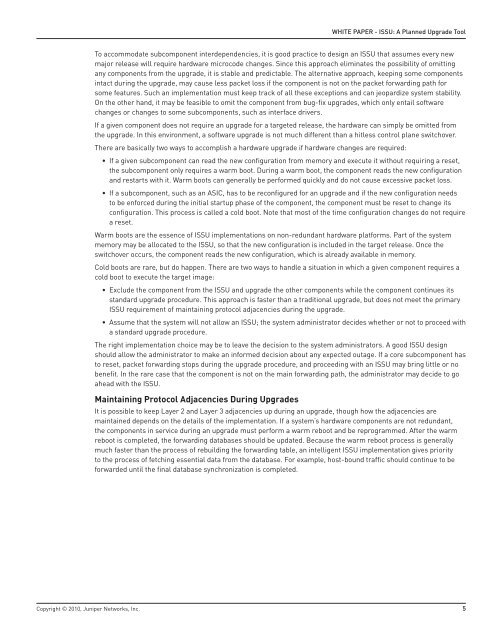ISSU: A Planned Upgrade Tool - Juniper Networks
ISSU: A Planned Upgrade Tool - Juniper Networks
ISSU: A Planned Upgrade Tool - Juniper Networks
You also want an ePaper? Increase the reach of your titles
YUMPU automatically turns print PDFs into web optimized ePapers that Google loves.
WHITE PAPER - <strong>ISSU</strong>: A <strong>Planned</strong> <strong>Upgrade</strong> <strong>Tool</strong><br />
To accommodate subcomponent interdependencies, it is good practice to design an <strong>ISSU</strong> that assumes every new<br />
major release will require hardware microcode changes. Since this approach eliminates the possibility of omitting<br />
any components from the upgrade, it is stable and predictable. The alternative approach, keeping some components<br />
intact during the upgrade, may cause less packet loss if the component is not on the packet forwarding path for<br />
some features. Such an implementation must keep track of all these exceptions and can jeopardize system stability.<br />
On the other hand, it may be feasible to omit the component from bug-fix upgrades, which only entail software<br />
changes or changes to some subcomponents, such as interface drivers.<br />
If a given component does not require an upgrade for a targeted release, the hardware can simply be omitted from<br />
the upgrade. In this environment, a software upgrade is not much different than a hitless control plane switchover.<br />
There are basically two ways to accomplish a hardware upgrade if hardware changes are required:<br />
• If a given subcomponent can read the new configuration from memory and execute it without requiring a reset,<br />
the subcomponent only requires a warm boot. During a warm boot, the component reads the new configuration<br />
and restarts with it. Warm boots can generally be performed quickly and do not cause excessive packet loss.<br />
• If a subcomponent, such as an ASIC, has to be reconfigured for an upgrade and if the new configuration needs<br />
to be enforced during the initial startup phase of the component, the component must be reset to change its<br />
configuration. This process is called a cold boot. Note that most of the time configuration changes do not require<br />
a reset.<br />
Warm boots are the essence of <strong>ISSU</strong> implementations on non-redundant hardware platforms. Part of the system<br />
memory may be allocated to the <strong>ISSU</strong>, so that the new configuration is included in the target release. Once the<br />
switchover occurs, the component reads the new configuration, which is already available in memory.<br />
Cold boots are rare, but do happen. There are two ways to handle a situation in which a given component requires a<br />
cold boot to execute the target image:<br />
• Exclude the component from the <strong>ISSU</strong> and upgrade the other components while the component continues its<br />
standard upgrade procedure. This approach is faster than a traditional upgrade, but does not meet the primary<br />
<strong>ISSU</strong> requirement of maintaining protocol adjacencies during the upgrade.<br />
• Assume that the system will not allow an <strong>ISSU</strong>; the system administrator decides whether or not to proceed with<br />
a standard upgrade procedure.<br />
The right implementation choice may be to leave the decision to the system administrators. A good <strong>ISSU</strong> design<br />
should allow the administrator to make an informed decision about any expected outage. If a core subcomponent has<br />
to reset, packet forwarding stops during the upgrade procedure, and proceeding with an <strong>ISSU</strong> may bring little or no<br />
benefit. In the rare case that the component is not on the main forwarding path, the administrator may decide to go<br />
ahead with the <strong>ISSU</strong>.<br />
Maintaining Protocol Adjacencies During <strong>Upgrade</strong>s<br />
It is possible to keep Layer 2 and Layer 3 adjacencies up during an upgrade, though how the adjacencies are<br />
maintained depends on the details of the implementation. If a system’s hardware components are not redundant,<br />
the components in service during an upgrade must perform a warm reboot and be reprogrammed. After the warm<br />
reboot is completed, the forwarding databases should be updated. Because the warm reboot process is generally<br />
much faster than the process of rebuilding the forwarding table, an intelligent <strong>ISSU</strong> implementation gives priority<br />
to the process of fetching essential data from the database. For example, host-bound traffic should continue to be<br />
forwarded until the final database synchronization is completed.<br />
Copyright © 2010, <strong>Juniper</strong> <strong>Networks</strong>, Inc. 5
















